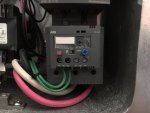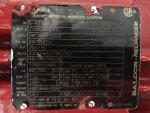Guys, thank you for all of your comments and help...
I was served with a problem and an installation that was already done which had some incorrect information beforehand.
Checking now the photos and the correct information, it is as follows....
At the moment we have a transformer (75KVA) supplying 208V to a panel (for the HPU skid - hydraulic power unit). This panel has the Siemens TypeQP 3P 60A breaker (like Jraef mentions, it looks like a residential breaker, see photo below), Siemens webpage mentions it's a thermal magnetic breaker.... From there we run a single cable of #6 for a lenght of 210ft (not sure of temp rating, need to find out, but true, I'm assuming 90C)... The cable connects to a junction box on the skid which has the motor contactors and an overload which the minimum setting is 75A...
View attachment 15543
View attachment 15542
Motor is dual voltage 230/460, 48/24, SF1.15... and at the bottom it does say "USABLE @ 208V with a current of 52A"...
View attachment 15541
With this being said, if we are running the motor at 208V then per NEC we have a FLC of 59.4A (FLA namplate= 52A). This would give us a max overload of 125% x 52A = 65A, overload is too high per NEC, unless they used the exception and multiplied by 140% to cover for inrush, which is still high. As for the cable (assuming 90C), a 6AWG 3/C would be good for 75A, which is above FLC of 59.4A x 125% = 74.25A...
As far as the breaker, since it's thermal magnetic, we use 250% for design B motor on inverse time breaker and the max would be 148.5 (size up to 150A).
One problem I see is that there's a voltage drop of about 10V with the 210ft lenght (siemens voltage drop calculator), so that would give us 197V at motor terminals.. They mentioned they measured 203V at motor terminals and running current of about 35A.
With no pressure at the hydraulic unit, motors starts and pressurizes the unit to 3000psi, when the pressure decreases to 2500psi, the motor starts, or at least tries to start, it hums for about 6 seconds and the breaker at the panel trips.
I know that the motor is usable at 208V, according to nameplate, but the unit was successfully factory tested at 240V.... My suggestion is to install a transformer that outputs 240V (or see if this same transformer can be wired delta-delta), where our cable lenght would give us a voltage drop of 10V and have 230V at the motor leads... As well as replacing the breaker with a thermal-mag that has an adjustable trip (like Jraef mentioned) rated at 150A so we can dial it back to 100A and go from there. Cable run would stay the same... Overload hmm, not sure... I guess that needs to be replaced per nameplate's FLA and NEC.
Any thoughts?
Thanks,
Fernando




